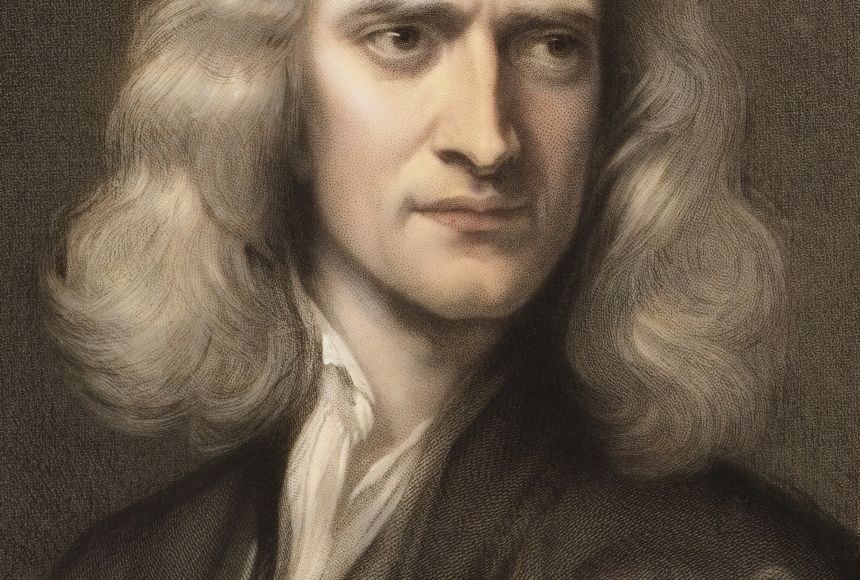Legend has it that Isaac Newton formulated gravitational theory in 1665 or 1666 after watching an apple fall and asking why the apple fell straight down, rather than sideways or even upward.
"He showed that the force that makes the apple fall and that holds us on the ground is the same as the force that keeps the moon and planets in their orbits," said Martin Rees, a former president of Britain's Royal Society, the United Kingdom's national academy of science, which was once headed by Newton himself.
"His theory of gravity wouldn't have got us global positioning satellites," said Jeremy Gray, a mathematical historian at the Milton Keynes, U.K.-based Open University. "But it was enough to develop space travel."
Isaac Newton, Underachiever?
Born two to three months prematurely on January 4, 1643, in a hamlet in Lincolnshire, England, Isaac Newton was a tiny baby who, according to his mother, could have fit inside a quart mug. A practical child, he enjoyed constructing models, including a tiny mill that actually ground flour—powered by a mouse running in a wheel.
Admitted to the University of Cambridge on 1661, Newton at first failed to shine as a student.
In 1665 the school temporarily closed because of a bubonic plague epidemic and Newton returned home to Lincolnshire for two years. It was then that the apple-falling brainstorm occurred, and he described his years on hiatus as "the prime of my age for invention."
Despite his apparent affinity for private study, Newton returned to Cambridge in 1667 and served as a mathematics professor and in other capacities until 1696.
Isaac Newton: More than Master of Gravity
Decoding gravity was only part of Newton's contribution to mathematics and science. His other major mathematical preoccupation was calculus, and along with German mathematician Gottfried Leibniz, Newton developed differentiation and integration—techniques that remain fundamental to mathematicians and scientists.
Meanwhile, his interest in optics led him to propose, correctly, that white light is actually the combination of light of all the colors of the rainbow. This, in turn, made plain the cause of chromatic aberration—inaccurate color reproduction—in the telescopes of the day.
To solve the problem, Newton designed a telescope that used mirrors rather than just glass lenses, which allowed the new apparatus to focus all the colors on a single point—resulting in a crisper, more accurate image. To this day, reflecting telescopes, including the Hubble Space Telescope, are mainstays of astronomy.
Following his apple insight, Newton developed the three laws of motion, which are, in his own words:
- Newton's Law of Inertia: Every object persists in its state of rest or uniform motion in a straight line unless it is compelled to change that state by forces impressed upon it.
- Newton's Law of Acceleration: Force is equal to the change in momentum (mV) per change in time. For a constant mass, force equals mass times acceleration [expressed in the famous equation F = ma].
- Newton's Law of Action and Reaction: For every action, there is an equal and opposite reaction.
Newton published his findings in 1687 in a book called Philosophiae Naturalis Principia Mathematica (Mathematical Principles of Natural Philosophy) commonly known as the Principia.
"Newton's Principia made him famous—few people read it, and even fewer understood it, but everyone knew that it was a great work, rather like Einstein's Theory of Relativity over two hundred years later," writes mathematician Robert Wilson of the Open University in an article on a university website.
Isaac Newton's "Unattractive Personality"
Despite his wealth of discoveries, Isaac Newton wasn't well liked, particularly in old age, when he served as the head of Britain's Royal Mint, served in Parliament, and wrote on religion, among other things.
"As a personality, Newton was unattractive—solitary and reclusive when young, vain and vindictive in his later years, when he tyrannized the Royal Society and vigorously sabotaged his rivals," the Royal Society's Rees said.
Sir David Wallace, director of the Isaac Newton Institute for Mathematical Sciences in Cambridge, U.K., added, "He was a complex character, who also pursued alchemy"—the search for a method to turn base metals into gold—"and, as Master of the Mint, showed no clemency towards coiners [counterfeiters] sentenced to death."
In 1727, at 84, Sir Isaac Newton died in his sleep and was buried with pomp and ceremony in Westminster Abbey in London.

